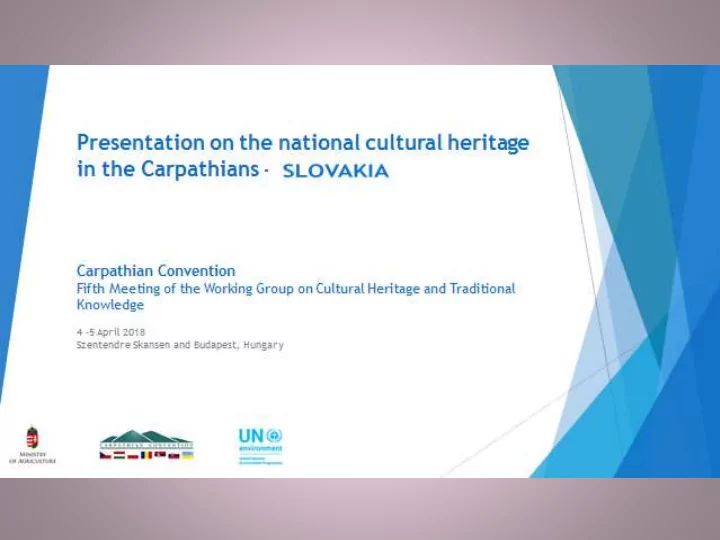

Presentation on the national cultural heritage in the Carpatians - SLOVAKIA Carpathian Convention Fifth Meeting of the Working Group on Cultural Heritage and Traditional Knowledge 4.-5. April 2018 Szentendre Skansen and Budapest, Hungary
HISTORICAL FACTS AND CONTEXTS
Habitation of the territory and its significantce Finding the skull fills • prehistoric period – „ Homo neandertalensis “ • migrations + colonization waves : • 4 – 3 th century BC. - Celts, opidum • 5 -6th century – the end of migration of nation - • 11 – 16th century – Hungarian colonization • 12 – 18th century - German colonization (4 waves) • 14- 17th century - Wallachian colonization • 17 th other ethnicities • crossing of historic trade routes : • Amber way • Czech way • Magna via
Via Bohemica • Prague - Budin (hun. Buda; today Budapest) • crossed the southwest of Slovakia • was part of a longer European journey from the Bosphorus to the Altantic Ocean • in 1335/1336 officially recognized by Karl Róbert (Hungerian king) + Ján Luxemburg (czech king) strategic importance already in Great Moravia Ostrý Kameň - passage the area of Great today's appearance the through the small Moravia way – Prievaly, SK Carpathians
Amber way • Aquileia (Jadran) - Emona (Ljubljana ) - Savaria (Szobmbately) – Carnuntum Map of route (Hainburg) – Devín – Moravian gate – Vroclaw - Calisia (Kalisy) - a Torun - Balt (the mouth of the Visla River) • crossed the southwest of Slovakia „Devín gate“ - led along the Little and White Carpathians to Bohemia • Ptolemaios menchioned it • Transportation - amber, animals, fur, leather, feathers, slaves in the South and glassware, bronze, silver to the North • the most used since the end of the 7th century BC to the 5th century
Magna via ( Austria – Hungary) • major imperial - royal postal route • very important especially afrer the battle at Mohac (1526) - breaking the connection of Vienna with the mining towns (BŠ, BB, Kremnica) • the longest post and road, built in 1550 • Vienna – Mukacevo – Debrecen - Hermannstadt (Sibiu, RO) • 18th century - expansion + developing (station for horses, taverns with accommodation • their arrival was announced by a trumpet that has remained the symbol of the post.
Fortifications and Castles - defense and road safety
Diversity of urban and rural architekture - Profane architecture
Diversity of urban and rural architekture
Archaeological finds and locations Bzovík, fortified monastery Sitno, ruin fortified dwelling
Sacral buildings - monasteries, churches, chapels, calvary
Medieval churches (Gemer) - beauty of Gothic
Industry and technical monuments
Historic regions of Slovakia
Sources of livelihood forest management , , winemaking, agriculture shepherding sheep horse breeding, catle + domestic animals breeding,
transport of wood along the water and in the mountains
Mining of ores and minerals
Craftsmanship and livelihood wire products
Blacksmith - iron and metal products ( horseshoe, lock, iron cross, gargoyle, decorative fittings,...)
Glass products – bottles, pepettes, wineglasses ...
Clay products, ceramics
Straw products
Blueprint
Leather products - furry, garbiar manufacture of pipes
Laces, embroidery
Spinning, weaving, combing the feathers
wooden products – bowl, cup, trough, teaspoons, wooden crosses, whistles, fujara
Puppetry
Folk costumes
Dances, singing
Slovak traditional dishes – gingerbread, potato gnocchi with sheep cheese and bacon, smoked cheese, pasties from potato and bucwheat flour, gnocchi with poppy
Customs, rituals
Customs, rituals
The diversity of the cultural expression of the nation The Carpathians are our common welth. Thank for your attention Budapest, 4.4.2018 zuzana.klasova@pamiatky.gov.sk
Recommend
More recommend